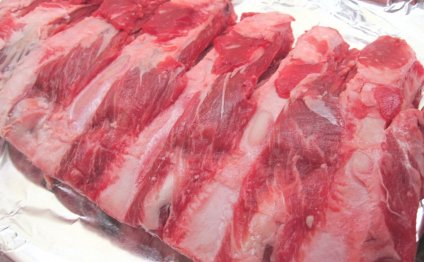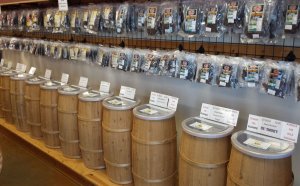
Slab of Beef
The level, or very first slice, of brisket: It really is slim and vulnerable to dryness after a long cooking time. [Photo: Vicky Wasik]
Both first in addition to 2nd slices are hard, meaning they truly are full of muscle-strengthening collagen. It requires a number of years to melt collagen into tender gelatin, so hard cuts are routinely slow-cooked. The process usually one of many complications of lengthy cooking is a loss of moisture, which happens as muscle fibers agreement and press down their water content. For some collagen-rich difficult slices, that is not a big problem, since they normally have adequate damp fat to compensate when it comes to losing water. But brisket is a weird situation: The first cut is extremely slim, with very little fat excluding a layer that operates along its top area. Just the second-cut is laced with sufficient fat, ensuring juiciness despite a lengthy braise.
The brisket's second-cut, or point, is wealthy with intramuscular fat, producing a wet piece of meat despite extended cooking. [Photo: Vicky Wasik]
In most cases once you buy a brisket, however, you do not have the fatty 2nd cut—you only have the slim, dryness-prone flat. The simplest solution to the dry-brisket issue, after that, is to purchase one aided by the fatty second-cut affixed (or perhaps buy the fatty second-cut and ditch the initial slice completely). Any braised brisket meal made out of the 2nd slice is much better. But, regrettably, the second slice is challenging find—many meat manufacturers do not sell it—and, since I understand some folks wont want to bother monitoring it down, we resolved a recipe utilizing just the very first cut that nonetheless arrives juicy.
There are two key tips to rendering it work. The foremost is to braise the brisket in a sealed vessel. This works counter to one of our primary beef stew rules (which implement equally well to braises), particularly, you want to partly protect the braise to permit steady evaporation of fluid and surface browning regarding the beef, leading to much better taste development. In my own examinations, i came across that lean brisket prepared in an entirely sealed vessel retained more liquid than brisket which was partly revealed. Also brisket that has been prepared mostly covered, then uncovered during the last 30 minutes to brown a little, revealed increased drying out. It really is a sacrifice to get rid of some of that browning and taste development, but it's an essential anyone to stop the meat from drying out.
The next key to juicy brisket would be to thinly slice the beef once it's done, and submerge the slices when you look at the braising fluid for approximately 30 minutes before serving. Thinly slicing the animal meat increases its surface, enabling you to reveal more of the animal meat to your braising juices, moistening it more fully. It is not unlike Cuban ropa vieja, wherein a lean cut of beef is cooked until dropping apart—and additionally totally dry—then shredded into slim strands being thrown inside cooking liquid. The stringy shreds of meat have a great deal surface, all of it coated in preparing drinks, which they appear wet while they have completely dried out during cooking. (aided by the brisket, however, as opposed to shredding its long muscle tissue materials into strands, we are cutting across all of them to shorten the fiber length while increasing its tenderness.)
[Photo: Vicky Wasik]
My real cooking process goes similar to this: I start with browning the brisket to build up a number of its taste. This is specially crucial, because itwill be covered inside range therefore don't brown later on. When you yourself have a big stainless steel roasting pan, you can brown the brisket inside the cooking pan. If you do not, it is possible to put the brisket on a rack set-in a rimmed baking sheet and brown it beneath the broiler. Kindly, however, whatever you do, don't cut any fat off the brisket—the lean level slice needs most of the fat it may get.
In addition brown the aromatics; which, the carrots, onion, celery, and garlic. Once more, for those who have a suitable roasting cooking pan, this can be done in the pan following the animal meat has come down. If you don't, you are able to brown all of them in a skillet with some oil. In a lot of our meat stew dishes, we add aromatics like carrots later on in the lengthy cooking procedure, to assist them to retain taste and surface. Possibly it's just nostalgia for how I ate this brisket as a kid, but element of the things I love about it is the way all of the vegetables break up to make a thick, chunky, profoundly flavorful sauce. We place them all-in right from the start.
I quickly stir in handful of ketchup (you may also utilize tomato paste, but i prefer the simple hit of vinegar and sugar from the ketchup), and some broken entire tomatoes and their particular drinks.
After the meat and veggies are browned, we deglaze any browned bits with handful of dry red wine. However take it all together in a pan large enough to put up it—either that very same heavy-duty roaster you've been making use of for anything else, or a thin-walled aluminum or disposable roasting pan—and cover it with foil.
It's really worth noting that there's no opinion anyway about what should go into a Jewish braised brisket. I seen recipes that call for orange liquid, Coca-Cola, or plenty of ketchup, and add-ins like figs and ginger. I keep mine extremely easy, simply tossing-in some thyme and bay leaves for organic aromatics, and leave it at that. It's not only the flavor profile We grew up with; additionally it is the one that speaks to the potential of perhaps the most rudimentary pair of ingredients.
[Photo: Daniel Gritzer]
Utilizing the brisket all set, I place it in a reduced 300°F oven until it's tender, which takes approximately three and four-hours. To be honest, my inclination is prepare the brisket at an even reduced temp, about 275°F. The lower the range is, the less rapidly the muscle tissue materials will contract, and also the juicier the animal meat would be. The thing is that there's an excessive amount of difference in oven behavior to recommend a temperature that reduced. Some ovens, for instance, will drop too much underneath the specified heat, evoking the beef to just take repeatedly for as long to prepare. Therefore 300°F is a safer quantity, allowing even more room for mistake therefore much more trustworthy outcomes (although you should nevertheless always utilize a thermometer to verify your oven is calibrated correctly).
Share this Post
Related posts
Reference Book
Whom received? what questions to ask a guy how much marketing manager make how many working days in a month? who developed…
Read MoreWhat is interesting about Texas
The second largest state in the US, Texas - the Lone Star State - has a wealth of natural assets and cultural attractions…
Read More










